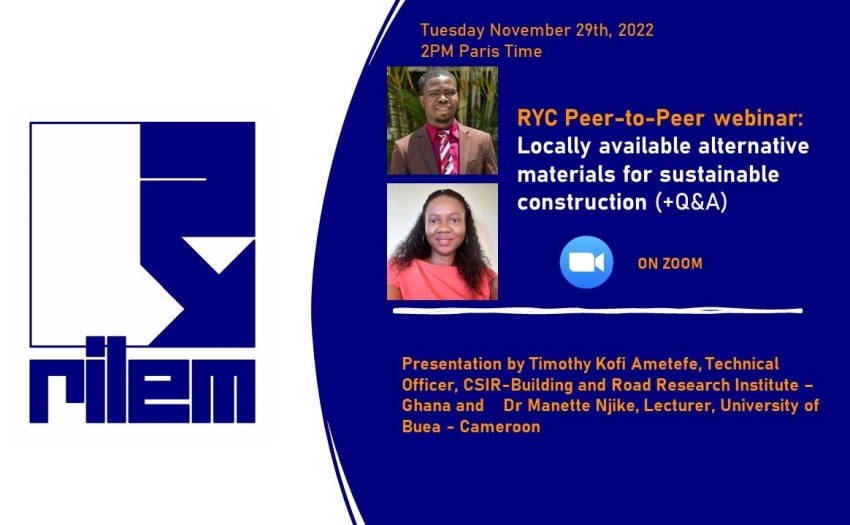Events calendar
Region : Sub-Saharan Africa

RYC Peer-to-Peer Webinar: Locally available alternative materials for sustainable construction
The next Peer-to-Peer webinar will take place on Tuesday November 29th, 2022 at 2PM Paris Time and will be one hour long (2*20 minutes presentations + 15-minute interaction). The registration for this webinar is free.
Theme of the Peer-to-Peer Webinar: Locally available alternative materials for sustainable construction
REGISTER FOR FREE HERE.
Speaker 1: Timothy Kofi Ametefe, Technical Officer, CSIR-Building and Road Research Institute - Ghana
Title: Mechanical and durability properties of low grade calcined clay concrete
Concrete is a ubiquitous building material due to its versatility, durability, availability and cost advantages over other building materials. In order to make concrete more sustainable, researchers have focused on lowering the proportion of ordinary Portland cement (OPC), the most expensive and highest embodied carbon among all the materials used for concrete. In this work, low grade calcined clay was used to replace OPC at 50% by weight. The calcined clay concrete was compared with the control in terms of strength (compression and flexural) and durability (Rapid chloride permeability test and resistance to acid attack). The results of the study indicated that both the control and the calcined clay concrete were suitable for a C30 concrete classification after 28 days curing in saturated lime water. For the flexural strength, the control was 36% higher than the calcined clay. With the durability the calcined clay concrete showed a lower permeability to chloride than the control concrete. The calcined clay concrete also exhibited a higher resistance to the attack of acid than the control concrete. The 50% calcined clay concrete was suitable for C30 concrete mix and is recommended for construction.
Speaker 2: Dr Manette Njike, Lecturer, University of Buea - Cameroon
Title: Potential of Straw- Gum Blocks as Building Material
The increasing demand of raw material for construction, the environmental burden of construction industry are some of the compelling arguments to embrace new technologies that contribute to carbon footprint reduction, and develop infrastructures that can respond to the climate. In response to this, the development of new building’s materials like straw bale has advanced in the construction industry. Straw bale presents many advantages like low carbon footprint and can significantly reduce building’s energy consumption. However, it has low compressive strength and displays high displacement under compression load. So far, no attempt has been made in order to enhance the strength of straw bales. This study aimed to develop alternative material to straw bale using chopped straw stems mixed with a binder (gum Arabic). Results obtained show that the compressive strength of straw blocks (1.25MPa) is greater than the strength of straw bales (0.02MPa). Also, the average displacement recorded during compression test on straw blocks (29mm) was 2.8 times smaller than the displacement in straw bales (80mm). Furthermore, test results show that plastered straw block assemblies can support at least 286 KN/m2 which is higher than the minimum slab load (18.25KN/m2 ) for residential house. The use of gum arabic helps in holding straw stems together and forms a compact material with improved strength compared to straw bale. Therefore, performance improvement of the characteristics of load-bearing straw bale walls can be addressed by using straw blocks.
No comment
Log in to post comment. Log in.





